Anti-tank SAU of Germany during the war (part 8) - Jagdpanther
Having in their arsenal an excellent 88-mm long-barreled weapon, developed on the basis of a well-proven anti-aircraft gun, German engineers made more than one attempt to install it on a tank chassis. Thus, Ferdinand and Nashorn ACS were born. The first of them was very heavy and difficult to manufacture, and the second could not boast of a serious booking. The most suitable option for the installation of the new gun seemed to be the chassis of the medium tank PzKpfw V "Panther". The decision to create a new ACS at its base was taken on 3 August 1942 of the year, at a time when there was work to create a base tank. Initially, the project was going to be entrusted to Krupp, which at that time was already working on installing a new 88-mm gun on the chassis of the PzKpfw IV tank, but in the middle of October 1942, further development of the SAU was transferred to Daimler-Benz.
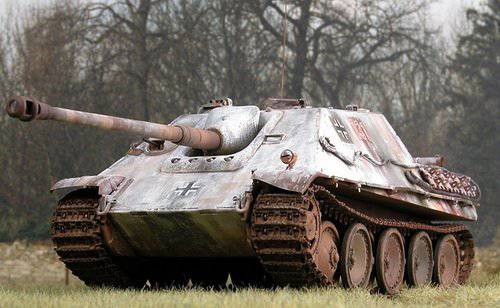
5 January 1943 of the year at a meeting of the technical commission of the Daimler-Benz concern a number of requirements were determined for the future ACS. Initially, the tank destroyer was supposed to be unified with the Panther II tank under development, but after the Ministry of Weapons adopted the 4 in May 1943, the decision to temporarily freeze the Panther II project to the SAU developers had to make a number of serious designs for unification with the Panther medium tank. changes.
As a result of all this, as well as the transfer of production to the factories of the MIAG company, the first sample of this very necessary machine for the front, which received the designation Jagdpanther, was shown to Hitler only 20 of October 1943 of the year and immediately received its approval. The remaining practically unchanged chassis of the Panther tank was equipped with a well-protected armored shell, which has a perfect ballistic profile. A significant drawback could be the limitation of the pickup angle in the horizontal plane, if the tank destroyer did not have an excellent control system, which made it easy to deploy the ACS and ensure high accuracy of aiming the gun at the target. According to its characteristics, the weapon that was installed on the “Yagdpanter” surpassed all the allied tank guns. A similar gun was installed only on a heavy tank PzKpfw VI "Tiger II". Armor-piercing shells of the gun at a distance in the 1 kilometer pierced armor 193 mm thick.
The first self-propelled guns began to arrive in the Wehrmacht in February 1944. Initially, it was believed that these vehicles will be produced in the amount of 150 self-propelled guns per month, but because of the constant bombing aviation Allies and the fact that the self-propelled gun was created on the basis of the main and perhaps the best Wehrmacht tank, the production of which was given the highest priority, German factories managed to produce only 1945 self-propelled guns "Yagdpanthera" until April 392. We can say that the troops of the anti-Hitler coalition were lucky, since the Jagdpanther was one of the best tank destroyers of the Second World War, fighting extremely effectively against the Allied tanks.
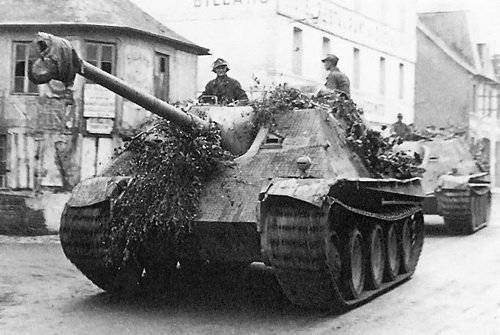
Design features
The Jagdpanther was the most effective German tank destroyer. This PT-ACS successfully combined good armor protection, firepower, and excellent mobility.
The body of the self-propelled gun was welded from steel laminated heterogeneous plates, its weight was about 17 tons. The walls of the hull and the felling were located at different angles, which contributed to the dispersion of the kinetic energy of the projectiles. In order to increase the strength of the welds, the grooves and grooves were additionally strengthened. The forehead of the hull had a reservation in 80 mm and was located at an angle of 55 degrees. The logging boards had a reservation in 50 mm. and located at an angle of 30 degrees.
For the manufacture of self-propelled guns "Jagdpantera" used standard tank hull "Panther". In front of the case was the gearbox, to the left and to the right of it were a driver and radio operator. The MG-34 machine gun of 7,92-mm caliber was mounted opposite the place of the latter in the ball mount. The driver controlled the ACS using levers that turned on or off the onboard gears. The survey from the driver’s seat was carried out through a single or double periscope, which was placed on the frontal part of the hull. The radio station was on the right wall of the car body. The gunner-radio operator could observe the terrain only with the help of an optical sight of his course machine gun. Machine gun ammunition 600 cartridges, which were in 8 bags in ribbons on 75 cartridges to the right and left of the gunner-radio operator.
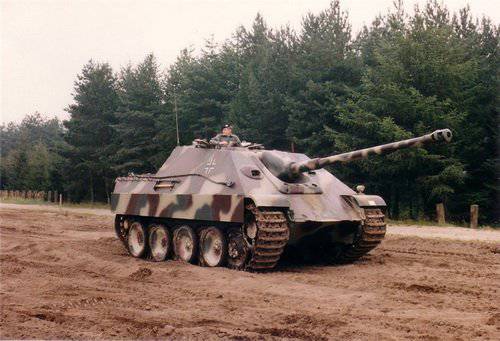
The central part of the vehicle’s hull is occupied by the fighting compartment, in which the breech of the StuN 88 / 43 X-guns and shelves with 3-mm shots are located. Here are the jobs of the rest of the crew members: the gunner, loader and commander. The fighting compartment is closed from all sides by a fixed wheelhouse, on its roof there are 88 round hatches for the crew. A rectangular hatch is located in the rear wall of the cabin, which serves to load the ammunition, eject the spent cartridges, dismantle the gun and evacuate the crew.
In the rear part of the case there was an engine compartment, fenced off from the combat compartment by a fire bulkhead. The engine compartment and the entire rear of the 1 chassis on the 1 were repeated in serial “Panther”.
ACS Jagdpanther equipped with a sufficiently powerful engine "Maybach" HL230Р30. This 12-cylinder V-shaped (camber of 60 degrees cylinders) liquid-cooled carburetor engine at 3000 rpm developed power in 700 hp, allowing the 46 ton self-propelled gun to accelerate to 46 km / h. The engine had four carburetors, the fuel in which was supplied using gas pumps "Solex". Additionally, the car had a manual emergency fuel pump. The fuel was placed in 6 tanks with a total capacity of 700 liters. Spare on highway reached 210 km.
The engine worked in conjunction with a mechanical, semi-automatic gearbox with preselection. The gearbox had 7 speeds forward and reverse. The gearbox was controlled hydraulically with a lever, which was located to the right of the driver's seat.
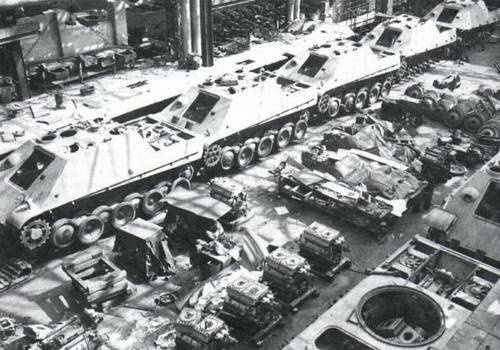
From its "progenitor" - the medium tank PzKpfw V "Panther" - SAU Jagdpanther inherited exceptional smoothness. The undercarriage of the tank has a “chess” arrangement of support rollers (Knipkamp design), which provides a more even distribution of pressure on the ground and a good smoothness. Along with this, this design is very difficult to manufacture and especially to repair, and also has a very large mass. To replace just one roller from the inner row, it was necessary to dismantle from 1 / 3 to half of all external rollers. On each side of the ACS accounted for 8 rollers large diameter. Double torsion bars were used as elastic suspension elements; the front and rear pair of rollers had hydraulic shock absorbers. Leading rinks - front.
The main armament of the Jagdpanther tank destroyer was an 88-mm StuK 43 / 3 cannon with a barrel 71 caliber (6 300 mm). The total length of the gun was 6595 mm. Vertical pickup angles ranged from -8 to + 14 degrees. The angles of horizontal guidance were 11 degrees in both directions. The weight of the gun was 2265 kg. The gun was equipped with a hydraulic type recoil mechanism. The normal rollback of the gun was equal to 380 mm, the maximum 580 mm. In the event that the rollback exceeded 580 mm, it was necessary to take a break in shooting. The gun was equipped with electric trigger, the shutter release button was located near the gunner’s place. Ammunition guns was 57 shells. For firing were used armor-piercing, sub-caliber and high-explosive fragmentation projectiles. The shots were located along the sides and on the floor of the fighting compartment. In the stowed position, the barrel of the gun was given an elevation of 7 degrees.
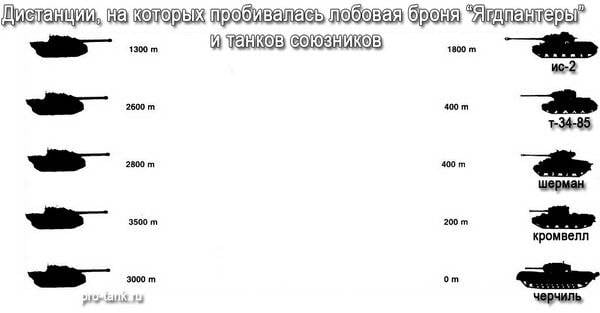
The PT-SAU Jagdpanther was originally equipped with SflZF5 sights, a late-release machine with WZF1 / 4 sights. The SflZF5 sight is a telescopic sight with a single lens. He provided the 3's magnification to the gunner and had a field of view of 8 degrees. The sight was calibrated to 3 000 meters when firing PzGr39 / 1 armor-piercing shells and to 5 300 meters when firing PzGr 40 / 43. The maximum firing range was 15 300 meters. The WZF1 / 4 scope was also telescopic, but provided an increase in 10-x and had a field of view in 7 degrees. The sight was calibrated to 4 000 meters for projectiles PzGr39 / 1, 2 400 meters for PzGr40 / 43 and 3 400 meters for high-explosive shells.
An additional weapon of the self-propelled gun is the 7,92-mm MG-34 machine gun with ammunition in 600 cartridges. The machine gun is in the ball mount to the right of the gun. Optical sight machine gun provides 1,8 fold increase. The machine gun has declination / elevation angles -10 + 15 degrees and a firing sector in 10 degrees (left and right on 5). Empty cartridges and empty machine-gun belts are collected in a special bag attached to the machine gun. In addition, "Jagdpanther" additionally armed with a melee "Nahverteidungswafte", which could fire fragmentation, smoke, lighting or signal grenades. The grenade launcher had a circular sector of fire and had a fixed angle of elevation (50 degrees). The firing range of fragmentation grenades was 100 meters.
use Features
Initially, Jagdpanther’s self-propelled guns were to be supplied to individual heavy anti-tank battalions consisting of three companies, each with 14 SAU, and another tank destroyer 3 belonged to the battalion headquarters. The leadership of the Wehrmacht ordered to use self-propelled guns only to counter enemy tank attacks. The ACS in the division should have ensured rapid success in crucial areas. The use of tank destroyers in parts was not allowed. The use of platoons "Yagdpanter" was allowed only in some cases, for example, during the storming of the enemy fortified positions. Without extreme necessity, they were not allowed to be used as fixed firing points. After solving the combat mission, the SAU was instructed to immediately divert to the rear for technical inspection and repair.
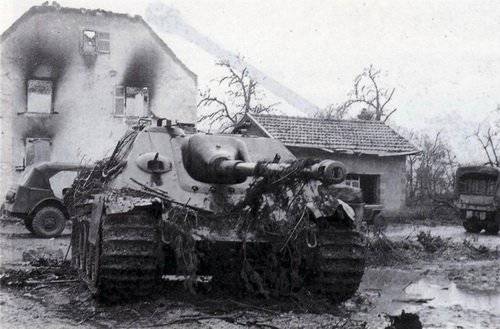
These recommendations, especially in the last months of the war, were not very feasible. Therefore, most often ACS were used as a porotno, making up one of the three companies of the anti-tank battalion. The most massively used Jagdpanther during the Arden operation. It was attended by at least 56 machines as part of the 6 battalions of tank destroyers, as well as around 12 machines as part of various SS units. On the Eastern Front, the machines were most massively used during the battles under Lake Balaton and during the defense of Vienna. Then most of the ACS was part of the hastily made SS compounds, PT-ACS were used along with the tanks, and often simply replaced them in the newly created compounds. Despite the high losses during the Arden operation and the low rates of production on the 1 in March 1945, the Wehrmacht numbered the 202 tank destroyer "Yagdpanther"
Performance characteristics: Jagdpanther
Mass: 45,5 t.
Dimensions:
Length 9,86 m., Width 3,42 m., Height 2,72 m.
Crew: 5 people.
Reservations: from 20 to 80 mm.
Armament: X-NUMX-mm cannon StuK88 / 43 L / 3, 71-mm MG-7,92 machine gun
Ammunition: 57 projectile, 600 ammo.
Engine: 12-cylinder gasoline liquid-cooled engine "Maybach" HL HL230Р30, power 700 hp
Maximum speed: on the highway - 46 km / h, over rough terrain - 25 km / hour
Power reserve: on the highway - 210 km., Over rough terrain - 140 km.
Information